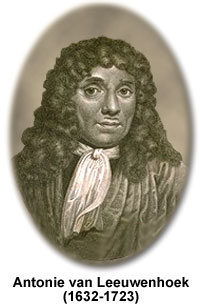Antonie van Leeuwenhoek
(1632-1723)

Leeuwenhoek was born in Delft, Holland on October 24, 1632. His father was a basket-maker, and although Leeuwenhoek did not receive a university education and was not considered a scholar, his curiosity and skill allowed him to make some of the most important discoveries in the history of Biology.
He was educated as a child in the town of Warmond, lived with his uncle in Benthuizen, and apprenticed in 1648 as a fabric merchant. He returned to Delft, and established his own business as a fabric merchant, but also worked as a surveyor, a wine assayer and as a city official.
At some time before 1668, Antonie van Leeuwenhoek learned to grind lenses, and used these to make very simple hand-held microscopes. These microscopes were not compound microscopes made of two or more lenses but refined magnifying glasses made with finely ground lenses. These microscopes, with appropriate lighting, allowed him to magnify objects over 275 times. His curiosity about this microscopic world and his diligence in recording his observations allowed him to share with others what he had seen with his microscopes.
Leeuwenhoek hired an illustrator to draw what he saw and he wrote explicit descriptions of the microorganisms he saw through his microscopes. He studied Protists, plant cells, various types of algae, and was the first person to view bacteria, which he termed "animalcules". Leeuwenhoek discovered these bacteria while viewing scrapings from his teeth and the teeth of others. He also discovered blood cells and was the first to see living sperm cells in animals.
For fifty years, Leeuwenhoek wrote letters to the Royal Society of London, in which he described his findings. His letters concerning these discoveries became so famous that they were published and translated into many other languages. In 1680 he was elected a full member of the Royal Society, which was normally reserved for scientific scholars. He died on August 30, 1723 but has since been recognized as one of the most important scientists of the day.
Leeuwenhoek Microscopes - Leeuwenhoek designed and built several hundred microscopes that were all very small and had a very similar design and function. The dimensions of his microscopes were fairly constant at approximately two inches long and one inch across. The main body of these microscopes consists of two flat and thin metal (usually brass) plates riveted together. Sandwiched between the plates was a small bi-convex lens capable of magnifications ranging from 70x to over 250x, depending upon the lens quality.
